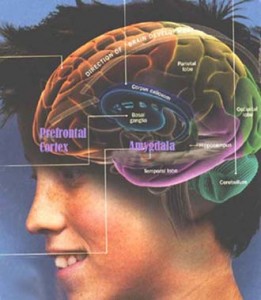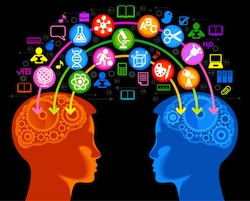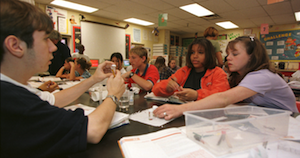How to Build Happy Middle School Brains
Judy Willis is a board-certified neurologist and middle school teacher in Santa Barbara, California. She’s the author of many articles and books that help educators translate brain research into effective teaching and learning strategies.
by Judy Willis

Teachers can take advantage of this natural cycle in human development if we understand what’s going on and adjust our pedagogy accordingly. We can help our middle grades students build happy, learning brains through interactive, interdependent group work.
In early elementary school, students often raise up from their seats and wave their hands enthusiastically in hopes of being called upon to answer a question. By middle school, some students consider it uncool to volunteer answers or even appear smart in class. Students may not see school as related to their personal lives. They may become disengaged with the more complex curriculum, particularly if they experience less choice and more isolation.
However, these same students are more willing to participate and even show enthusiasm about challenging tasks when they are engaged in learning activities with supportive peers.
Brain research tells us that adolescents experience more comfort and enjoyment when pleasurable social interaction is incorporated into their learning experiences. “Inclusion” in this context refers to a sense of belonging to a group where a student feels valued and begins to build resiliency. Resilient students have greater success, social competence, empathy, responsiveness, and communication skills. They also demonstrate greater flexibility, self-reflection, and ability to conceptualize abstractly when solving problems.
Successfully planned group work is one brain-friendly strategy for supporting students during their most stressful period of development — by increasing choice and relevance and building supportive classroom communities, which in turn increase self-esteem and academic performance.
Some of the brain science
Middle school is one of the most physiologically, emotionally, and socially stressful times of one’s life. The hormonal assaults, the increasing importance of peers over family in one’s sense of identity and self worth, and the brain’s second big burst of neural development all occur in the middle grades.
It is during adolescence that students’ bodies seem to mature ahead of their judgment. Neuro-imaging has confirmed that indeed this is the case. The frontal lobes are part of the brain’s emotional circuit. They also control executive functions such as organization, critical analysis, judgment, focusing attention, and prioritizing. These lobes are the last part of the brain to mature and this happens sometime during adolescence. Because students have not reached the brain maturity to completely manage their emotions, middle school teachers need to monitor and model supportive emotional climates.

When the amygdala is in this hyper-excitable, anxiety-provoked state, there is profound reduction in the neural activity that we associate with information flow into and out of the amygdala. In a normal relaxed state, the brain receives information as sensory input and neural pathways project this information to the amygdala. If the information passes successfully through the amygdala into the hippocampus, emotional meaning may be linked to the information and connections are made with previously stored, related knowledge. The new information, now enhanced with emotional or relational data, then travels along specific neuronal circuits to the higher cognitive centers of the brain, where information is processed, categorized, and stored for later retrieval and executive functioning. (Kato 2003)
We know from brain scans of adolescents that when they are in states of affective emotional anxiety, and the amygdala is metabolically hyperactive, the pathways in the brain that normally conduct information in and out of the amygdala show greatly reduced activity. As a result, new information/learning is blocked from entering the memory banks by a metabolic blockade.
On the other hand, when students participate in learning activities that interest them, and do so in low-stress, high-engagement states, their brains are in the physiological state that results in low filter, high information transport. This condition is enhanced by choice, personal interest, prior experience and intrinsic motivation — the same factors that accompany progress toward an academic goal in which the student feels invested — and it happens during learning activities in well-designed, supportive cooperative groups.
Successful group work
In successful group work among adolescents, students’ affective filters are not blocking the flow of knowledge. When a teacher plans group work in a way that assures each member’s strengths will have authentic importance to the ultimate success of the group’s activity, the teacher is creating a situation where individual learning styles, skills, and talents are valued. Students shine as each exhibits his or her strengths, and they learn from each other in the areas where they are not as expert. They call on each other’s guidance to solve pertinent and compelling problems and develop their interpersonal skills by communicating their ideas to partners.

With the confirmation of the affective filter’s role as a gateway for information processing, it becomes critical that teachers use the supportive strategies available to help students build their self-esteem and resilience to the stresses they will face.
Building classroom communities that are supportive and not threatening, through practices such as cooperative learning, class celebrations, weekly meetings, peer mediation, and school-community collaborations are compatible not only with the art of good teaching, but also with the brain research on learning. Community and self-esteem building are not strategies just for elementary school. And they are not just “nice to do.” It is now evident through functional imaging that practices like these, which lower threat and stress, serve to facilitate the successful passage of knowledge through the brain’s filters and into cognitive processing. Students learn more.
Planning for success
Taking all this brain research into account, let’s consider what it means to have middle grades students do “cooperative work.”
In this context, cooperative work is not accomplished simply by having individuals working in parallel in a group. Students should need each other to complete the task. Teachers need to create a learning environment where students participate in tasks that are clearly constructed and where each task must be completed in order for the group to be successful. The teacher should remain active as a circulating resource and when necessary, an arbitrator, but the challenge put before students should be such that they are capable of carrying out their tasks without constant, direct intrusion by the teacher.
In this brain-friendly model, adolescent students, not the teacher, are responsible for accomplishing their tasks in the way they think best, with accountability to each other and to the teacher’s standards. Ideally there is a clear rubric for individual and group assessment and the students and the teacher take part in the assessment process.
Some research-based guidelines
When setting up lessons for successful collaboration in cooperative groups, consider these guidelines. I’ve also included an example from my own classroom of how a teacher might meet some of these guidelines.
• All group members have opportunities and capabilities, frontloaded if necessary, such that different students can make their own special contributions. This may require planning ways for students with different learning/intelligence styles to make special contributions to the group task. (Webb 1998)
• Students learn to respect each other as group members. Often this requires teacher demonstration with role-playing.
• The group negotiates roles with guidance from the teacher. Designated roles can include recorder; participation monitor (someone who keeps track of who is participating such that if one member has already given three suggestions and others have not had a chance, the overly active participant is asked to give others time to present their views); creative director (if a physical product such as a poster or computer presentation is part of the project); materials director (as might be needed for science or art projects), etc.
• There should be more than one answer or more than one way to solve the problem or create the project.
• The activity should be intrinsically interesting, challenging, and rewarding.
“What is Life?” group problem analysis
Engaging all students in group learning at the beginning of a unit of study increases relational memory. By presenting the Big Picture through a comprehensive experience that links with some area of student interest, past experience, or real world connections, we can trigger relational memories and activate the hippocampus, where connections are made with the new information that allow it to be coded into recognizable and storable patterns.
For example: If the initial presentation of a new unit incorporates sports, popular music, and audiovisual technology, at least one of these will resonate with most middle school students through their primary or secondary learning strengths or interests. This initial exposure to the topic will stimulate their connection to the lessons that follow, because they were engaged early around their own interests or personal experiences.
Starting with an innovative presentation such as a guest speaker — or by posing a thought provoking question through a demonstration — can engage students. Here is an opening activity from my own science class:
By prompting students to define what it means “to be alive,” I engage them in a personally relevant introduction to a biology unit. I help students organize themselves into cooperative groups to define what constitutes a living organism and to record their responses. They then practice prioritizing and ordering (executive function skills), as well as the social skill of reaching a consensus as they decide as a group which characteristics of being “alive” are most significant in defining life.

Students will show they are authentically engaged when they start making personal connections and asking the kinds of questions that relate their initial experience to concrete references or abstract connections. Students can have valid responses that they will be motivated to share because they are personally touched in some way by this activity.
Once my students are connected to the topic through their discussions, they are ready to be engaged in the study of single cellular organisms because they are in the low stress, high interest brain state — with unrestricted affective filters and increased release of dopamine.
Helping students “check in”
As the groups are working, teachers can promote the desired cooperative behavior by modeling how students can check in with each other to answer these questions periodically during the activity:
1. Is everyone talking?
2. Are you listening to each other?
3. Are you asking questions of fellow group members? What could you ask to find out someone’s ideas?
4. Are you giving reasons for ideas and expressing different opinions?
5. What could you ask if you wanted to find out someone’s reason for a suggestion?
A more joyful learning place
Successful group work results in the highest level of conceptual learning, when new information is connected with prior knowledge, and the dendritic circuits formed become accessible for solving new problems and interpreting subsequent related information. (McGroarty 1989) Group work results in increased conceptual learning, creative problem solving, increased oral language proficiency, and increased metabolic and neuro-electrical activity in the learning regions of the brain.
Similarly, with enough preparation for success and clearly defined rubrics for assessing and giving student feedback on individual and group success, students can be given more responsibility in their own assessment. This involvement can include filling out rubrics evaluating their own strengths and areas where improvement is needed in their individual contributions to the group — as well as assessing their cooperative behaviors as a member of the group.
The classrooms where students are engaged in well planned cooperative work are more joyful places in which management issues diminish and students develop social and learning skills. They are places where we can put up the sign: Happy Brains At Work.
It’s reassuring in times of rigid curriculum requirements to have not only the academic and social evidence of the benefit of cooperative activities, but to also have the objective neuro-scientific data to support what teachers — and for that matter what ants and bees — have known all along.

© 2012 by Judy Willis
Photo 1: Integral Options Cafe
































Once again, Judy Willis teaches us all about how to apply the latest brain research to the everyday activities in classrooms–increasing the chances that they are places of substantive teaching and learning. Bravo!